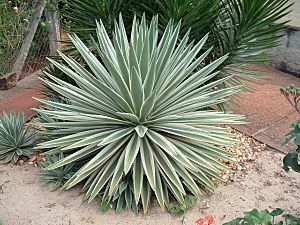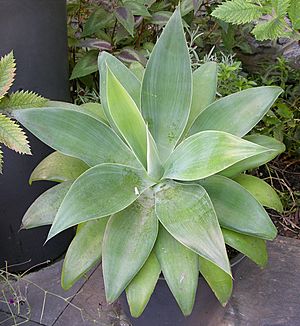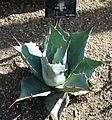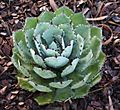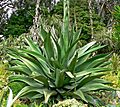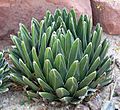Agave facts for kids
Quick facts for kids Agave |
|
|---|---|
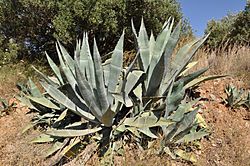 |
|
| Agave americana (Century Plant) | |
| Scientific classification | |
| Kingdom: | |
| Division: | |
| Class: | |
| Order: | |
| Family: | |
| Genus: |
Agave
|
Agaves are a type of succulent plant. They come from Mexico and the southwestern United States. These plants have thick, sharp leaves. Agave plants flower only once in their lives. After they produce seeds, they die. Before flowering, they usually live for 10 to 25 years.
Agaves were a very important food source for many Native American groups. This includes the Navajo and the Hohokam in the southwestern United States.
Contents
What Agaves Look Like
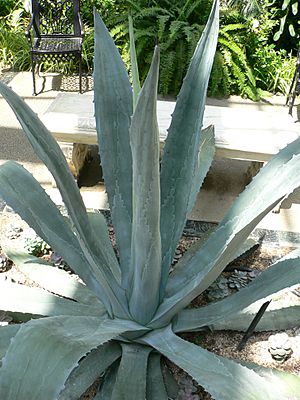
Agaves are succulents. This means they store water in their leaves. They have a large rosette of thick, fleshy leaves. Most species have a sharp point or spine at the end of each leaf. The main stem is usually short, making the leaves look like they grow right from the ground.
Many Agave species are popular ornamental plants. People like to grow them in hot, dry places. This is because agaves need very little water to survive. They are often grown in gardens in places with warm climates.
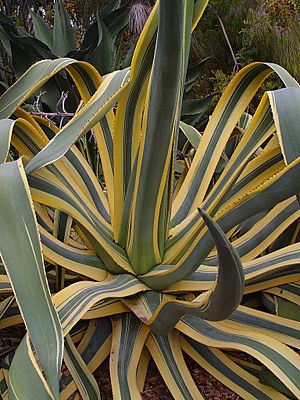
Some people mistakenly think agaves are cacti. However, agaves are not related to cacti. They are also not closely related to Aloe plants, even though their leaves look similar.
The larvae (young forms) of some Lepidoptera (like butterflies and moths) eat Agave species. One example is Batrachedra striolata.
How People Use Agave
Food and Drinks from Agave
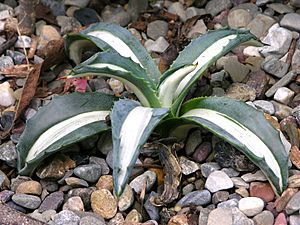
Each agave plant produces several pounds of flowers that can be eaten. This happens during its last season before it dies. The stalks, which are ready in the summer before the flowers bloom, are also very heavy. When roasted, these stalks are sweet. You can chew them to get a sweet liquid called aguamiel, similar to sugarcane. Once dried, the stalks can even be used to make musical instruments like didgeridoos.
The leaves can be gathered in winter and spring. This is when the plants have a lot of sap, making them good for eating. The leaves of several agave types also provide strong fibers. For example, Agave sisalana gives us sisal hemp. Agave decipiens gives us false sisal hemp. Agave Americana is a source of pita fiber. This fiber is used in Mexico, the West Indies, and southern Europe.
The agave, especially Agave murpheyi, was a main food source for Native American people long ago in the Southwestern United States. The Hohokam people in southern Arizona grew large fields of agave.
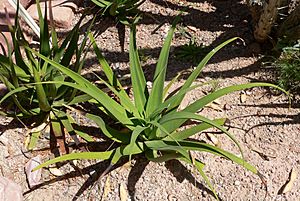
The Navajo also found many ways to use the agave plant. They would squeeze a drink from the baked fibers. The plant heads could be baked or boiled, then flattened into sheets, dried in the sun, and saved for later. These baked, dried heads were also boiled and made into an edible paste. They could be eaten whole or made into soup. The leaves were eaten boiled. Young, soft flowering stalks and shoots were roasted and eaten too. The strong fibers were used to make rope. Leaves were used to line baking pits. The sharp leaf tips were even used to make tools for weaving baskets.
When the flower stalk grows, sap rushes to its base. This sap is used to make Agave nectar (also called agave syrup). This is a sweetener used instead of sugar in cooking. It can also be added to breakfast cereals to help bind them together.
Agave sweetener is often sold as a natural choice that is good for people with diabetes. This is because it does not cause blood sugar levels to rise quickly. Scientists are also studying extracts from agave leaves. They are looking into how these might be used as food additives.
The sap from A. americana and other agave types is used in Mexico and Mesoamerica. It is used to make pulque, which is a fermented drink. The flower shoot is cut, and the sap is collected and then fermented. By distilling this fermented sap, a strong spirit called mezcal is made. One of the most famous types of mezcal is tequila.
Agave in Research
Agave plants can be used to make fructans in factories. Fructans are a type of prebiotic dietary fiber. This means they are good for your gut health.
Agave naturally grows in tough environments. Because of this, scientists are studying it. They are looking into how agave might help us understand and prepare for the effects of climate change. It might also be used as a source for bioethanol or other bioenergy materials.
Images for kids
-
The large flower spike of Agave chiapensis, San Francisco Botanical Garden
-
A row of agaves in bloom in the Karoo region of South Africa: The inflorescences of the plants are clearly visible.
-
Fibers inside a huachuca agave leaf (Agave parryi)
-
Agave harvesting in Java, 1917
-
Variegated Century Plant -- Agave americana 'Marginata'
-
Agave parrasana (syn. Agave wislizeni subsp. parrasana)
-
Agave salmiana var. ferox
-
Agave sisalana (sisal)
-
Agave sisalana (flowers)
See also
 In Spanish: Agave para niños
In Spanish: Agave para niños


